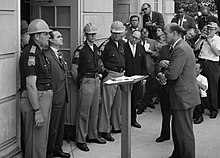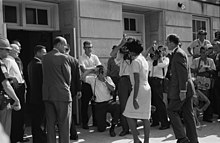Stand in the Schoolhouse Door


As a stand in the Schoolhouse Door is called an event from June 11, 1963 at Foster Auditorium of the University of Alabama . George Wallace , the governor of Alabama , demonstratively stood in the door of the auditorium to deny entry to the two African American students Vivian Malone Jones and James Hood . Wallace was trying to symbolically keep the promise he had made when he took office, namely " segregation now, segregation tomorrow and segregation forever" and stop the desegregation of schools.
The incident attracted the attention of the entire nation to George Wallace.
background
On 17 May 1954, gave the Supreme Court of the United States the lawsuit Brown v. Board of Education of Topeka held, in which the plaintiffs argued that racial segregation between black children and white children in public schools was unconstitutional.
The verdict in the Brown v. Board of Education meant that the University of Alabama had to be desegregated. In the years that followed, hundreds of African Americans applied for admission to the university, but they were all turned away. The university worked with the police to find reasons for disqualifying them or, if they failed, to intimidate applicants. In 1963, however, three African Americans with impeccable qualifications, Vivian Malone Jones , Dave McGlathery, and James Hood , competed and withstood any attempt at intimidation. In early June 1963, a federal judge ordered the three to be admitted to college and banned Governor Wallace from interfering.
The incident
On June 11th, Malone and Hood arrived to enroll. Governor Wallace tried on the one hand to keep his promise, on the other hand to stage a political show by personally blocking the entrance to the Foster Auditorium in front of the media. Then Deputy Attorney General Nicholas Katzenbach , accompanied by Federal Marshals, told Wallace to step aside. Wallace cut Katzenbach off and refused. Instead, he gave a speech on the rights of the US states. Katzenbach phoned US President John F. Kennedy , whereupon this unit of the Alabama National Guard ordered to the scene. General Henry Graham said to Wallace, "Sir, it is my sad task to ask you, on behalf of the President of the United States, to stand aside." Wallace continued, but finally moved.
Movies
- The incident is taken up in a scene from the film Forrest Gump , in which Forrest Gump appears at the scene, digitally copied into an original film recording in the media.
- Wallace is a1997US biography bi-movie directed by John Frankenheimer .
- The dialogue between Wallace and Katzenbach is shown in the documentary Four Little Girls by Spike Lee .
Web links
Individual evidence
- ↑ a b Debbie Elliot: Wallace in the Schoolhouse Door ( English ) National Public Radio . June 11, 2003. Retrieved June 26, 2009.
- ↑ Governor George C. Wallace's Schoolhouse Door Speech ( English ) Retrieved on June 27 of 2009.
- ↑ a b c Standing In the Schoolhouse Door (June) ( English ) Veterans of the Civil Rights Movement. Retrieved June 26, 2009.
- ↑ "Sir, it is my sad duty to ask you to step aside under the orders of the President of the United States."
- ^ Stephan Lesher: George Wallace: American Populist ( English ). Da Capo Press, 1995, ISBN 9780201407983 , p. 233.
- ^ Thomas Byers, History Re-Membered: Forrest Gump, Postfeminist Masculinity, and the Burial of the Counterculture . In: Modern Fiction Studies . 42.2, 1996, pp. 419-444. Retrieved February 28, 2009.
- ↑ Paul Grainge: Memory and Popular Movie ( English ). Manchester University Press, p. 229 (accessed June 26, 2009).